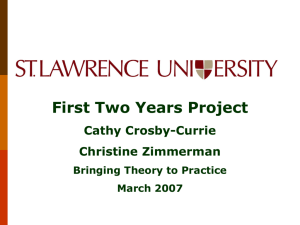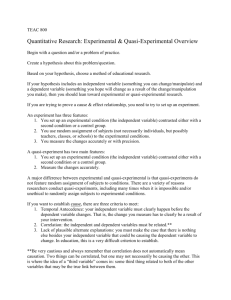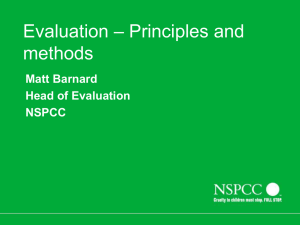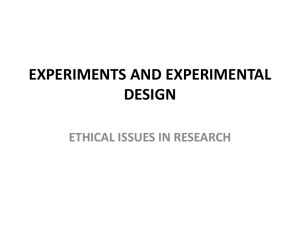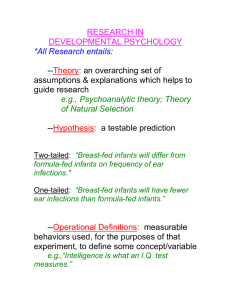quasi-experimental evaluations
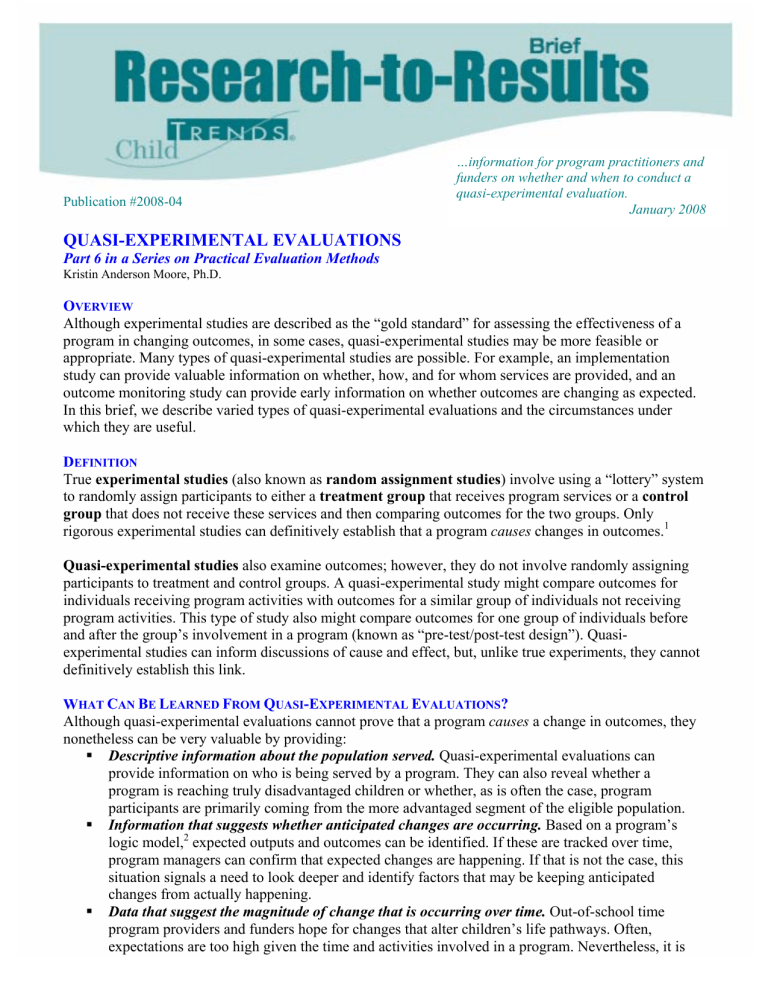
Publication #2008-04
…information for program practitioners and funders on whether and when to conduct a quasi-experimental evaluation.
January 2008
QUASI-EXPERIMENTAL EVALUATIONS
Part 6 in a Series on Practical Evaluation Methods
Kristin Anderson Moore, Ph.D.
O VERVIEW
Although experimental studies are described as the “gold standard” for assessing the effectiveness of a program in changing outcomes, in some cases, quasi-experimental studies may be more feasible or appropriate. Many types of quasi-experimental studies are possible. For example, an implementation study can provide valuable information on whether, how, and for whom services are provided, and an outcome monitoring study can provide early information on whether outcomes are changing as expected.
In this brief, we describe varied types of quasi-experimental evaluations and the circumstances under which they are useful.
D
EFINITION
True experimental studies (also known as random assignment studies ) involve using a “lottery” system to randomly assign participants to either a treatment group that receives program services or a control group that does not receive these services and then comparing outcomes for the two groups. Only rigorous experimental studies can definitively establish that a program causes changes in outcomes.
1
Quasi-experimental studies also examine outcomes; however, they do not involve randomly assigning participants to treatment and control groups. A quasi-experimental study might compare outcomes for individuals receiving program activities with outcomes for a similar group of individuals not receiving program activities. This type of study also might compare outcomes for one group of individuals before and after the group’s involvement in a program (known as “pre-test/post-test design”). Quasiexperimental studies can inform discussions of cause and effect, but, unlike true experiments, they cannot definitively establish this link.
W HAT C AN B E L EARNED F ROM Q UASI -E XPERIMENTAL E VALUATIONS ?
Although quasi-experimental evaluations cannot prove that a program causes a change in outcomes, they nonetheless can be very valuable by providing:
Descriptive information about the population served.
Quasi-experimental evaluations can provide information on who is being served by a program. They can also reveal whether a program is reaching truly disadvantaged children or whether, as is often the case, program participants are primarily coming from the more advantaged segment of the eligible population.
Information that suggests whether anticipated changes are occurring. Based on a program’s logic model, 2 expected outputs and outcomes can be identified. If these are tracked over time, program managers can confirm that expected changes are happening. If that is not the case, this situation signals a need to look deeper and identify factors that may be keeping anticipated changes from actually happening.
Data that suggest the magnitude of change that is occurring over time.
Out-of-school time program providers and funders hope for changes that alter children’s life pathways. Often, expectations are too high given the time and activities involved in a program. Nevertheless, it is
important to be able to explore whether changes are small, medium, or large, compared with the expectations delineated in the logic model and compared with changes resulting from other program approaches.
Information on whether anticipated changes are occurring in some subgroups and not others.
Program evaluations often find that programs are more successful for some subpopulations than for others. It is helpful to know whether results are stronger for some groups than for others; for example, younger compared with older teens, low-income students compared with moderateincome students, or immigrant children compared with native-born children.
Information on whether some outcomes are changing while others are not.
Programs seeking to improve a number of outcomes may not be equally successful with improving all outcomes.
Perhaps, for example, program participants are demonstrating substantial improvements in school attendance, but not in reducing their fighting and bullying behaviors. Such a pattern would suggest that the program in question needs to strengthen its approach to problem behaviors.
W HEN I S I T A PPROPRIATE T O C ONDUCT A Q UASI -E XPERIMENTAL S TUDY I NSTEAD OF A R ANDOM
A
SSIGNMENT
E
VALUATION
?
Many circumstances call for serious consideration of a quasi-experimental approach. These include the following situations:
If random assignment is not feasible.
For example, if the mayor of a small city implements an out-of-school time program within his city, it isn’t possible to randomly assign similar cities to treatment and control groups, so a quasi-experimental study may be appropriate.
If random assignment is unethical or there is community or funder opposition.
For example, if a neighborhood is seen as extremely unsafe, offering an out-of-school time program to all eligible children may be seen as essential. Alternatively, a funder may insist on providing services to all children in a community. In such instances, objections may be raised about randomly assigning only some children to receive program services.
If random assignment is not affordable.
It can be quite costly to identify, track, and collect data from members of a control group. For example, if a program is implemented within classrooms in a school, it might be too expensive to collect data not only from 10 classrooms in a treatment group, but also from 10 classrooms in a control group. It should be noted, however, that some quasi-experimental studies can be rather costly as well.
If a program is still under development.
Given the cost and complexity involved in conducting a rigorous experimental study, it is appropriate to wait until a program is well-developed and has settled into a clear and consistent set of activities before conducting a random assignment experimental evaluation.
If the pool of potential participants is too small to fill both a treatment and a control group.
For example, in a small community, there may not be enough children or youth eligible for a program to have both a treatment group and a control group. In this case, a quasi-experimental pretest/post-test design may be a more feasible option.
If it is impossible to avoid “contamination” of the control group. For some programs, it may not be possible to keep children or youth in the control group from being affected by the treatment.
For example, as suggested by the “lunchroom effect,” students in the treatment group may talk to students in the control group about the program during lunch or other times, so the control group is also being influenced by the treatment.
If a random assignment study becomes contaminated. Sometimes, a random assignment study is designed and implemented, but something happens to undermine the random assignment.
3 For example, individuals assigned to be in the control group may be allowed into the treatment group by a staff member. This practice may turn the study into a quasi-experimental study.
If a program wishes to establish ongoing, internal evaluation capacity. Many programs seek to integrate ongoing evaluation activities into their operational capacities. Quasi-experimental methods are generally appropriate for these activities.
4
2
In sum, while a random assignment experiment may represent the most rigorous way to establish what works for out-of-school time programs, it is often not possible or not appropriate to conduct such a study.
As discussed below, a number of quasi-experimental approaches to examining outcomes are quite commonly used.
T YPES OF Q UASI -E XPERIMENTAL O UTCOME E VALUATIONS
Comparison with a similar group or community.
For example, outcomes for adolescents in a
Boys and Girls Club in one neighborhood might be compared with outcomes for adolescents in another Boys and Girls Club in a similar neighborhood.
Comparison with matched individuals.
For example, comparisons might be made between students involved in a program and students not involved in that program who are similar to program participants in terms of their age, gender, race, grades, receipt of free school lunches, absenteeism, and other characteristics.
A pre-test/post-test design, with the individual as his or her own comparison.
For example, the attitudes, knowledge, and behaviors of students in the fall might be compared with the same measures in the spring.
Use of statistical methods to control for measured and unmeasured variables.
Data on program participants can be analyzed in a number of ways.
5 For example, pre-test and post-test scores for adolescents in a new out-of-school time program offered by a school or agency can be compared with scores for a historical comparison group of adolescents in that school or agency the year before the program opened, if such data exist. Alternatively, studies of “dosage” can examine how often and how long participants attend a program to explain how such frequency and duration are associated with outcomes.
R
ISKS AND
O
BSTACLES
As with any research design, there are a few things to watch out for when planning or carrying out a quasi-experimental study. One potential risk is selecting a comparison population that is not really similar to the population being served. For example, if the comparison population is more advantaged than the population being served, then outcomes for program participants may seem less positive than they really are. Alternatively, if something happens to the comparison population – for example, if it gets served by a different, new program or a new community center opens in the neighborhood – then the value of making the comparison will be undermined.
It is also important to recognize fully that conducting a comparison group study is sometimes both demanding and costly; for example, if pre-test data and post-test data are collected for the study population and for the comparison population. In this case, it may be worth considering whether an experimental study might be a more cost-effective design, because such a design would allow for conclusions to be drawn about whether the program causes changes in outcomes for participants.
C ONCLUSION
Many types of quasi-experimental designs are possible. They vary widely in cost and difficulty. When a random assignment evaluation is not appropriate or feasible, conducting a quasi-experimental study can yield important information for out-of-school time programs.
3
1 It should be acknowledged that it is difficult to execute a perfect experiment for a social program because of problems with attrition, implementation, measurement, and the like. Also, even if an experiment is conducted with great rigor, a statistically significant impact at the .05 level still suggests a 5 percent probability that findings are due to chance.
2 A logic model is a visual representation of how a program is supposed to “work.” It relates resources, activities, and the intended changes or impacts that a program is expected to create. For more information, see Hamilton, J. & Bronte-Tinkew, J.
(2007). Logic models in out-of-school time programs. ( Research-to-Results Brief). Washington, DC: Child Trends.
3 Rossi, P. H., Lipsey, M. W., & Freeman, H. E. (2004). Evaluation: A systematic approach (7th ed., pp. 290). Thousand Oaks,
4
CA: SAGE Publications.
5
Hunter, D. E. K. (2006). Daniel and the rhinoceros.
Evaluation and Program Planning, 29 , 180-185.
Statistical strategies include multiple regressions that control for confounding factors, regression-discontinuity studies, and time-series analyses. For more information, see Rossi et al. (2004).
S PONSORED BY : The Atlantic Philanthropies
© 2008 Child Trends. May be reprinted with citation.
4301 Connecticut Ave, NW, Suite 350, Washington, DC 20008, www.childtrends.org
4
